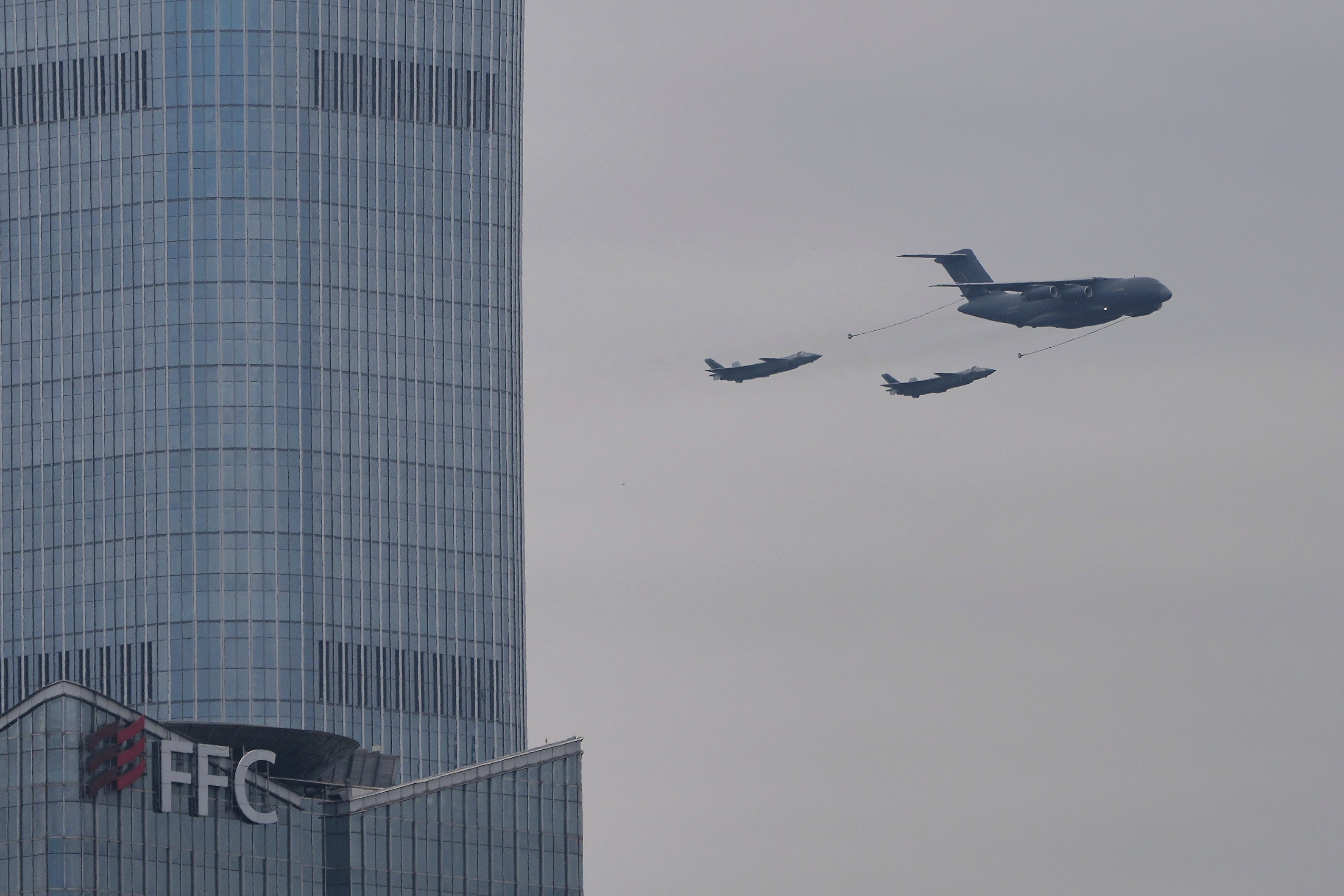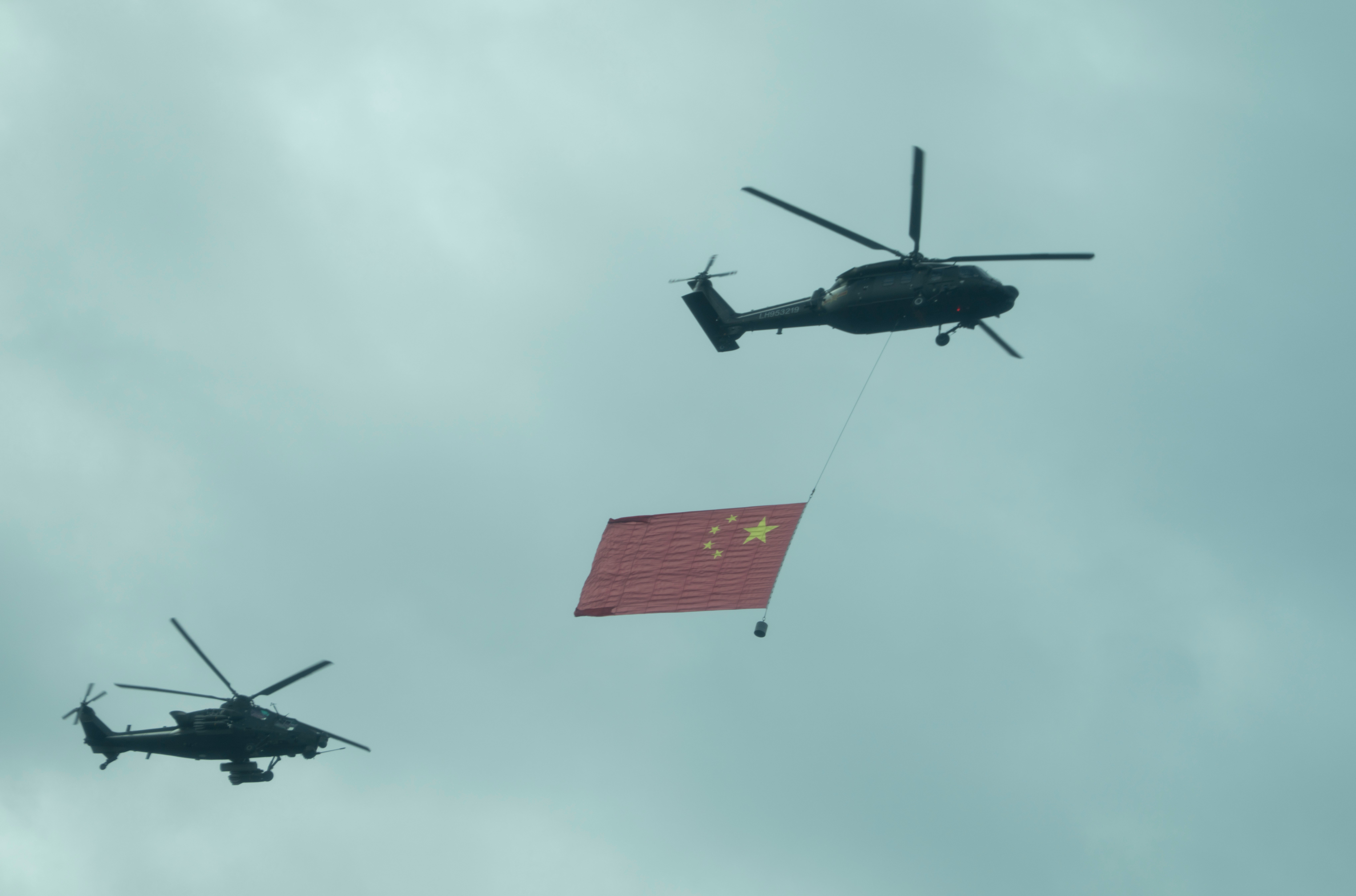China will host its largest-ever military parade on Wednesday as Xi Jinping positions himself as the biggest leader in the East to counter Donald Trump's aggressive trade and geopolitical policies.
President Xi will be joined by Russia's Vladimir Putin, North Korean dictator Kim Jong Un, and Iranian president Masoud Pezeshkian in a first instance of the four leaders coming together in a display of strength as Beijing showcases its latest generation of military technology.
The gathering of what Western analysts have dubbed as the "Axis of Upheaval", which includes a cohort of leaders of mostly 25 non-Nato countries, could build on a mutual defence pact signed by Russia and North Korea in June 2024.
The North Korean leader crossed into China early on Tuesday aboard his special train, en route to capital Beijing. Mr Xi and Mr Putin gathered at the Great Hall of the People for a meeting with Mongolia's leader, expected to touch on a vast gas pipeline project.
The Russian president thanked his "dear friend" Xi for the warm welcome and said the close communication showed Russia's relations with China were at an "unprecedentedly high level".
China’s display of mammoth military power on 3 September to mark the 80th anniversary of Japan’s Second World War surrender is poised to eclipse the tepid military parade held for Mr Trump’s 79th birthday last June. The parade is a flex aimed squarely at Mr Trump and his Western allies, which is likely to stoke the American president's ire even further.

The anticipated parade
Pictures leaked on Chinese social media showed the Chinese People's Liberation Army (PLA) was preparing to show off a lineup of new land and water-based weapons systems on 3 September to mark the 80th anniversary of Japan’s Second World War surrender.
The parade is likely to be one of the largest in China’s history, potentially eclipsing the 2015 parade marking the 70th anniversary. That event involved more than 12,000 soldiers and included international contingents from Russia, Belarus, Mongolia, Cambodia, and other nations.
President Xi, who is also the head of the military, will deliver a speech on the occasion, which will feature “new-type combat capabilities”, including hypersonic weapons and a range of electronic gear, Beijing has announced. He will review the assembled troops through the sunroof of a Chinese-made Red Flag limousine affixed with microphones and periodically say "Greetings, comrades", reports say.
He will be joined by world leaders to watch the rest of the parade that will pass through Tiananmen Square. Domestically, the commemoration is an effort to show how far the country has come, and in doing so, build support for the party and its leader.
China was a major front in the Second World War, a fact often overlooked in accounts that focus more on the fight for Europe and US naval battles in the Pacific. “It's a really important part of the Communist Party's legitimising narrative as the leader of the Chinese people," said Emily Matson, a scholar of modern Chinese history who teaches at Georgetown and George Washington universities.
Hundreds of aircraft, including fighter jets and bombers as well as ground equipment, some of which have never been seen in public before, will be featured in the parade, military officials said at a press conference.
From trucks fitted with devices to take out drones, new tanks and early warning aircraft to protect China's aircraft carriers, military attaches and security analysts say they are expecting China to display a host of new weapons and equipment at the parade.
China has the world’s largest standing military, with more than two million personnel , and an increasingly sophisticated arsenal of missiles, aircraft carriers, and fighter aircraft.
"China will showcase a new generation of nuclear weapons," analyst Song Zhongping told AFP. Nuclear weapons and other military hardware "will help equalise the military power balance between China and the US", he said.

Who is participating?
About 26 leaders, including the reclusive North Korean leader, will stand shoulder to shoulder with President Xi on Wednesday.
For Mr Kim, who crossed into China on his special train early on Tuesday, it will be his first major multilateral event and the first time a North Korean leader has attended a Chinese military parade in 66 years.
"The presence of Vladimir Putin, (Iran's) Masoud Pezeshkian, and Kim Jong Un underscores China's role as the world's leading authoritarian power," said Neil Thomas, a Chinese politics expert at the Asia Society Policy Institute's Center for China Analysis.
The increase in leaders from Central Asian, West Asian, and Southeast Asian countries attending this year's parade compared to the last one in 2015 highlight's Beijing's progress in regional diplomacy, he added.
Slovakian prime minster Robert Fico, the only Nato member, and Serbia's Aleksandar Vucic – both critical of sanctions on Russia over its war in Ukraine – are the only Western leaders attending.
Earlier this week, President Xi rallied leaders of developing nations to advocate for a more equal, multipolar world and promote the "correct historical perspective" of WWII at a regional security forum in the port city of Tianjin.
The parade too is part of a "memory war" in which China and Russia offer an alternative history to a Western narrative they believe underplays their role in fighting fascist forces, the Brookings Institution wrote in a paper last week.
Other guests expected to arrive in Beijing include Myanmar's junta chief Min Aung Hlaing, president Denis Sassou Nguesso of the Republic of Congo, and Pakistan’s prime minister Shehbaz Sharif.
Military hardware on display
The tightly choreographed 70‑minute parade offers a rare public window into China’s rapidly evolving military edge in a stark reminder not lost on Washington.
Beijing has claimed that all equipment on display are domestically produced and currently in service, with a redirected focus on the naval power as China escalates its pressure on Taiwan.
"China must develop powerful anti-ship and anti-aircraft carrier capabilities to prevent the United States from posing a serious threat to China's national security," Song Zhongping, a military commentator and former Chinese army instructor, told AFP, referring to tensions in the Taiwan Strait and the South China Sea.
Taiwanese president Lai Ching Te on Tuesday warned that the aggression will inevitably fail, pointing to the lessons from WWII and key victories Taiwan claims against Chinese forces in 1958.

Navy power
China is likely to display at least two types of extra-large uncrewed underwater vehicles (XLUUVs), according to leaked photos from the parade rehearsals.
The vessels, estimated to be around 60ft long, were seen being carried across the city on massive transport vehicles, Naval News reported. Their torpedo-shaped hulls and pump-jet propulsion systems revealed that the underwater vehicles were built to be stealthy.
Images showed one of the sea drones being marked as “AJX002”, while another type was photographed only under wraps.
🇨🇳 China is set to unveil the AJX-002, nuclear-powered, nuclear-capable extra large underwater vehicle (XLUUV).
— Vanguard Intel Group 🛡 (@vanguardintel) August 18, 2025
It measures 18-20 meters long and 1.5 meters in diameter, with pump jet propulsion and crane deployment lugs.
Comparable to Russia’s Poseidon nuclear torpedo, this… pic.twitter.com/IYMSaagnOu
Six of the drones were reportedly spotted during the rehearsal. Four matched the AJX002 profile, while two appeared slightly larger. The AJX002 features four lifting lugs along its hull, indicating that it is crane-assisted.
China operates the world's largest XLUUV programme with at least five distinct types already in the water, Naval News reported.
Armoured vehicles
The PLA will showcase its Type 99A main battle tank, which was developed as a replacement for the second-generation Type 88 tank, according to the South China Morning Post. The development process for the Type 99 series, also known as the ZTZ-99, began in 1989 based on the design of the Soviet-era T-72 chassis.
Weighing at around 55 tonnes, Type 99A tanks are the most advanced variant of the Type 99 series and have been deployed by the PLA since 2011. It features an upgraded 105mm main gun, an enlarged turret, a four-sided radar, and an integrated propulsion system.
The main battle tank operates with a crew of three and measures up to 36ft in length.
Medium_Tank
— 笑脸男人 (@lfx160219) August 17, 2025
ZTZ-201 & derivative infantry fighting vehicles (IFV) .the Chinese Army's new fourth-generation Medium Main Battle Tank.
➡️40-tonne class.
➡️New, next-generation 105 mm main gun.
➡️Remotely controlled turret, three-person crew compartment at the front of the hull.… pic.twitter.com/0zOTQk25Tq
The Type 99A main battle tank is equipped with an advanced targeting system that allows the gunner to engage one target while the commander independently tracks the next, the SCMP reported.
Its upgraded fire-control system features a third-generation thermal imager, meteorological sensors, and a ballistic computer, enabling precise engagement of targets at ranges up to 5km.
Nuclear-capable ballistic missiles
A intercontinental ballistic missile system and hypersonic anti-ship missiles are among the advanced weaponry the Communist government will display at the parade.
Photos on Chinese social media captured a new anti-ship missile from the YJ series being taken across the city for the parade rehearsals.
The new YJ-15 missile was spotted along with the YJ-17, YJ-19 and YJ-20 hypersonic missiles. The YJ missiles, short for "Ying Ji" or “eagle attack", can be launched from ships or aircraft and are designed to inflict critical damage on large vessels.
Various new missiles (ship UVLS launch?) confirmed, my 2c on roles:
— Rick Joe (@RickJoe_PLA) August 17, 2025
- YJ-15, ramjet compact supersonic?
- YJ-17, waverider hypersonic glide?
- YJ-19, ?maybe scramjet hypersonic?
- YJ-20, biconical hypersonic/aeroballistic? Possibly seen before from 055..
Via REautomaton, SDF pic.twitter.com/9061QDAi09
These sightings indicate China is advancing rapidly in hypersonic weapons technology, a field that has drawn global attention for its ability to evade traditional defence systems.
Also visible in the images was a new transporter-erector-launcher (TEL) vehicle carrying a large, tarp-covered missile canister, which could be a new ballistic missile system.
The anti-ship missiles and weapons with hypersonic capabilities will be particularly closely watched as the US and its allies prepare to counter China in any future regional conflict.
Loyal wingman drone
An uncrewed combat air vehicle (UCAV), believed to be a Collaborative Combat Aircraft or loyal wingman drone, was spotted on the streets of Beijing during the rehearsals. Experts say the UCAV, which was spotted at the back of a truck, resembles either the Chinese FH-97 or the American YFQ-42A.
Andreas Rupprecht, a Chinese military aviation expert, said that the scale of rehearsals alone already exceeds expectations.
“Just focusing on the aviation segment and what China is expected to showcase – the rehearsals for the parade alone are already exceeding everything one could have expected,” he told news outlet Defence Blog.







